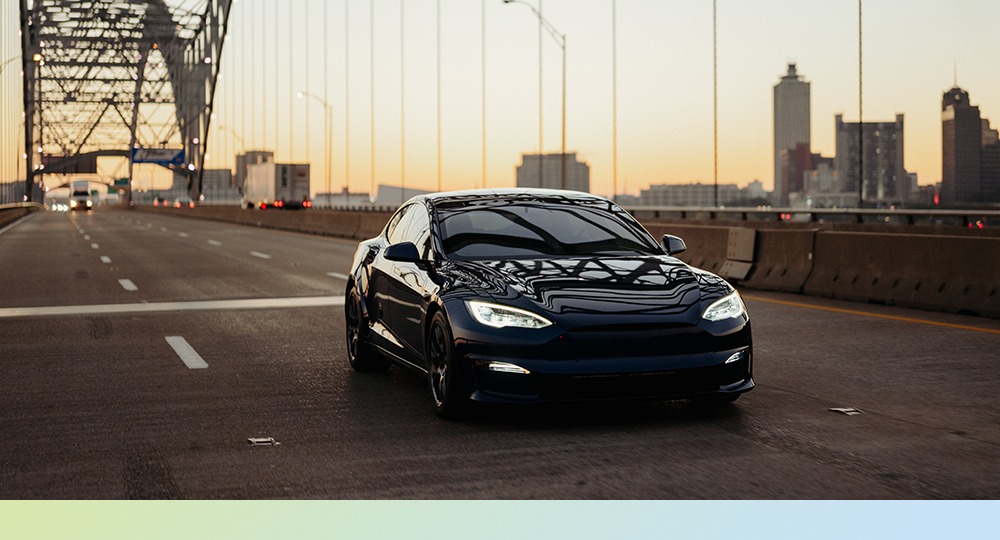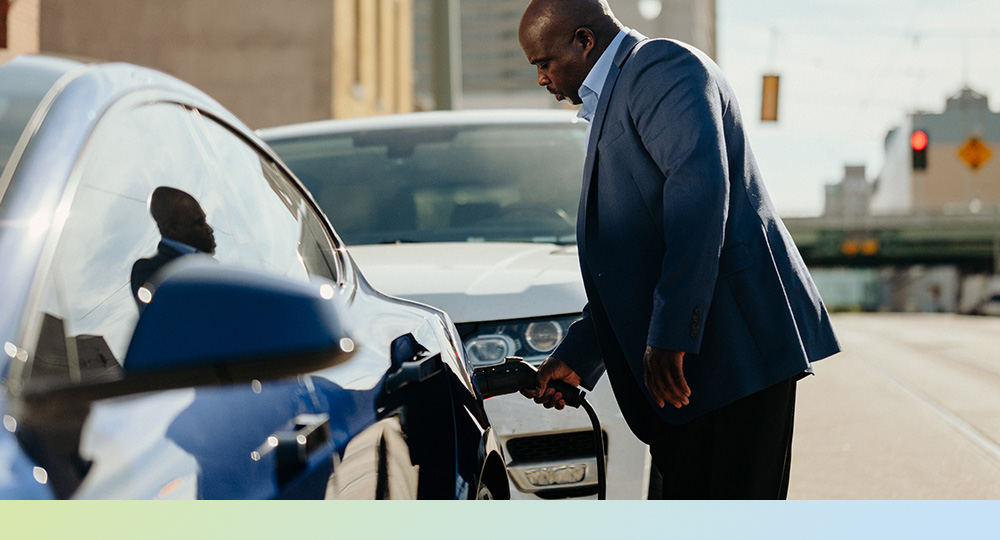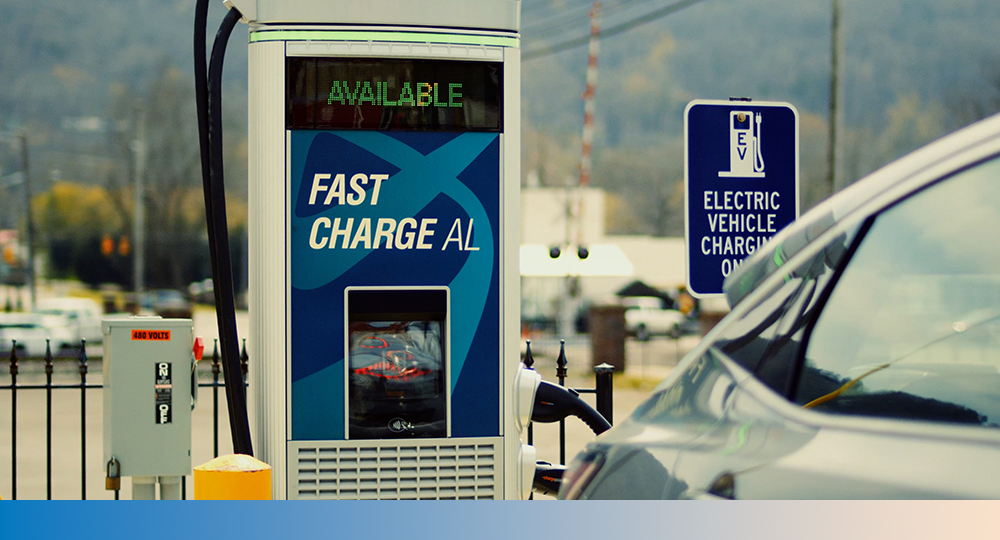Charging 101: Blow your mind (not fuses) with these top EV charging tips.

EV charging tips and information for safer electric fueling (AKA: charging)
We’ve touched on charging electric cars in several of our previous electric vehicle articles, but this installment is 100% all about getting charged up. Read on for EV charging tips and recommendations!
If you’ve just purchased an electric car, we encourage you to read the owner’s manual for information and recommendations specific to your make and model.
Let’s get charged up, shall we?
Know your EV charging levels
We’ve spent some time on charging levels already, so we’re sticking to the basics here. Be sure to check out “Is an electric vehicle right for me?” and visit TVA EnergyRight’s charging website for more information about EV charging levels.
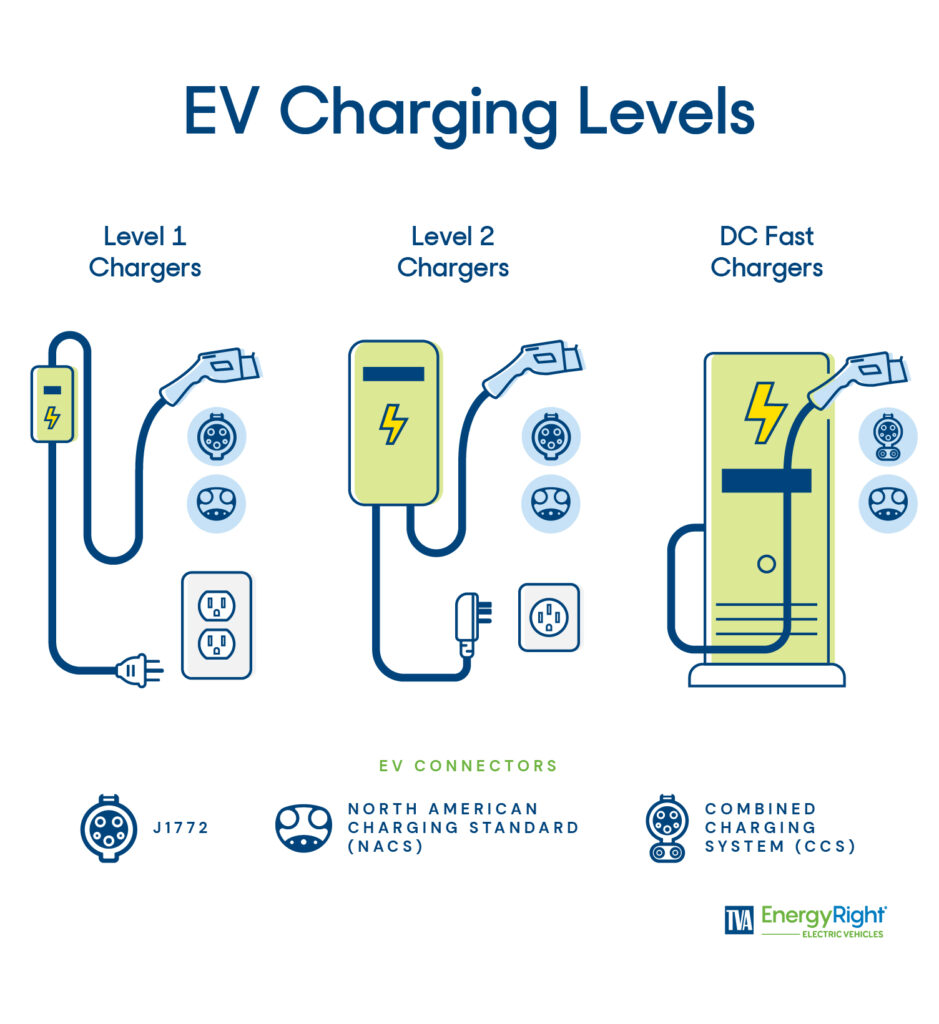
The three levels of EV charging:
- Level 1: Chargers that plug into a regular 120-volt home outlet, just like the one you use to charge your phone or toothbrush.
- Level 2: 240-volt chargers (like a dryer outlet) can fully charge an empty battery-only EV (BEV) in 4-10 hours.*
- DC Fast Charging: Typically found at public locations like malls or retail centers and off interstate exits. They’re intended for short stops on long road trips and can fill up a low battery in 20-60 minutes.
*Assuming a 60 kWh battery
Source: U.S. Department of Transportation
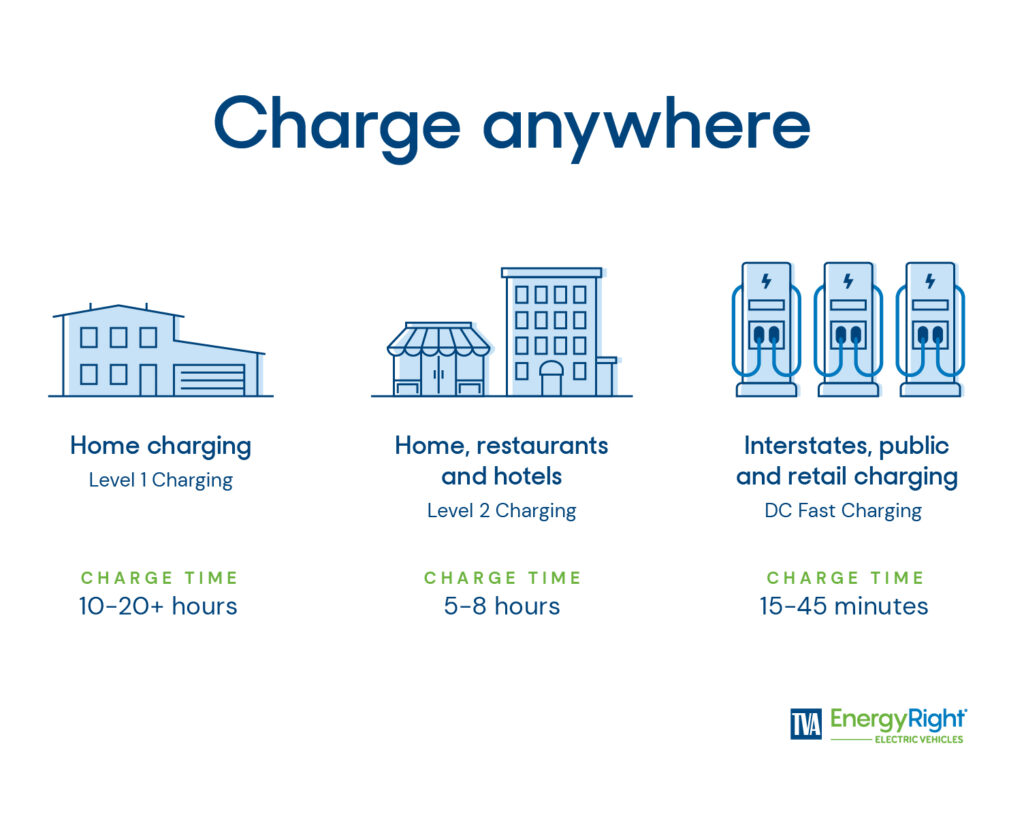
What you’re calling a charger probably isn’t a charger.
Technically speaking, a charger isn’t a charger.
Did we just blow a fuse?
That Level 1 or Level 2 charger in your neighbor’s garage and that fast charger around the corner from your office is actually a device known as electric vehicle service equipment (EVSE). Just rolls right off the tongue, doesn’t it?
The National Electronics Manufacturers Association (NEMA) tells us that although an EVSE is a more accurate name, most people are going to refer to that device as a “charging station” or “EV charger.”
And once you get past this explanation, so will we. Still, curious minds may want to know why an EV charger is also known as an EVSE.
For starters, the charger is actually built into the vehicle itself. The EVSE – that thing you plug into the wall outlet and will likely continue to call a charger or charging station – is essentially a very sophisticated extension cord.* Among other things, the EVSE tells the vehicle’s internal charger how much power is available and then sends the current to the car.
Read on to find out what else EVSEs do!
*Please Note: TVA EnergyRight does not recommend using a conventional extension cord to charge an EV.
Charging your EV at home is safe and convenient.

EVSEs (AKA charging stations) are truly incredible pieces of technology that help keep you, your electric car and your home safe. As approximately 80% of EV charging happens at home, it is essential that you have safe and reliable charging equipment, which should be installed by certified technicians.

Recalls on automobiles – both electric and gas-powered varieties – happen with some frequency. You can sign up for email alerts or search for recalls using your Vehicle Identification Number (VIN) on the National Highway Traffic Safety Administration’s (NHTSA) website. Or, you can sign up for recall alerts by downloading NHTSA’s SaferCar app on IOS or Android. NHTSA recalls also include equipment like charger cords, car seats and tires.
Now, let’s get back to our EV charging tips! Think of a charging station as a walkie-talkie that allows your charger and car to communicate about what’s going on with its fuel source: electricity.
Eight common charging station (AKA EVSE) safety features:
- Safety lock-out features prevent current from flowing through the charger cord when it isn’t connected – or isn’t connected correctly – into the car’s charging port.
- Auto-restart after a power outage.
- Short circuit or fault detection and shut off.
- Enclosures (the part of the unit that mounts to the wall) that meet NEMA safety requirements for water resistance, protection from dust, shock protection and more.
- Convenient power cable storage.
- Current regulation ensures that the current delivered to your car doesn’t exceed its capacity.
Advanced features of charging stations:
- Load detection capabilities that can sense other large electrical loads in your home (like dryers, hair dryers or electric heaters) and pause EV charging until the load eases.
- Wifi and app connectivity.
- Adjustable power capacity.
Source: Green Car Reports, ENERGY STAR
To compare EV chargers, Enervee® Scores, user ratings and more, visit the TVA EnergyRight Marketplace.
Can I charge my Rivian with a Ford charging station?
Yes! Another great feature of charging stations is that they enable interoperability; which is a fancy EV word for the ability to charge your Rivian or BMW i4 with a Ford Charge Station Pro or your Chevy Bolt with your friend’s home charger.
Interoperability isn’t limited to manufacturers’ charging stations. It also makes public charging easier and more accessible and plays a role in strengthening the charging infrastructure. We’d be remiss if we didn’t note that as of publication, you can’t charge your CSS-equipped Chevy with someone else’s home Tesla charger. That may change soon, however!
In November 2022, Tesla made its charging standard available to other EV manufacturers and renamed its charger to the North American Charging Standard (NACS). Ford and General Motors recently announced that starting next year, drivers will be able to charge their cars (with an adapter) at Tesla charging stations, the largest charging network in the country. They’ll also start offering models equipped with the NACS connections. In 2024, Stellantis became the last major North American automaker to announce its move to the SAE standardized charging connector.
To help speed the construction of a convenient, reliable charging network, the Biden-Harris administration announced a series of actions to encourage the creation of a Made-in-America EV charging network. To help facilitate EV adoption and travel in its service area, TVA EnergyRight is collaborating with state agencies, local power companies and third-party charging developers to develop the Fast Charge Network, which will place fast charging stations at least every 50 miles along major travel corridors in the seven-state region.
What is the Combined Charging System (CCS)?
If you’re buying a car in the U.S. then it will probably have a CCS combo plug, although Ford and GM will also offer the NACS plug in the coming years. The CCS is a standard for charging electric vehicles that can accommodate Type 1 and Type 2 AC charging and DC charging because it incorporates a J1772 outlet. For more on the AC/DC conversation, you’ll want to head over to our blog about electric vehicle battery basics.
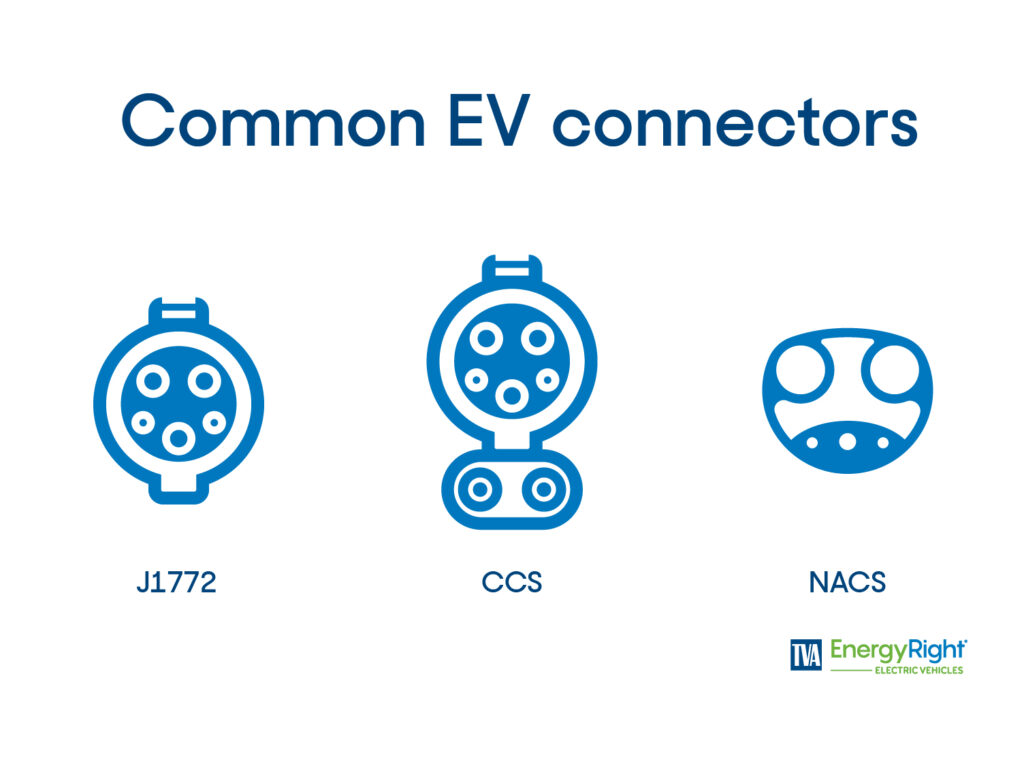
To qualify for federal funding as outlined by the Biden-Harris Administration, companies must adopt the CCS standard.
Although Tesla marches to its own beat, the company offers a CCS adapter so its drivers can charge at third-party charging stations. Plus, automakers such as Ford, General Motors, Rivian and others are partnering with Tesla to allow their EV drivers access through adapters as well.
Source: EV-america.com, livewire.com
Can I use an adapter to use a different charging standard?
With the exception of Tesla’s adapter, most manufacturers and third-party charging networks don’t recommend using adapters because they can increase the likelihood of faults. A fault is an abnormal electric current like a short circuit or open-circuit fault and may impact safety.
Source: electricityforum.com, EVgo.com
Do I need to have an EV charger professionally installed?
If you glean just one EV charging tip from this blog, it’s this: Don’t make charger installation a DIY project. The EV owners we spoke to strongly recommend having a Level 2 home charger professionally installed.
Gas station owners don’t install their own gas pumps. Why should you install your own EV charger? Leave this one to the pros!
Is it safe to charge my electric vehicle outdoors if it’s raining?
In an interview for Autotrader.com, Nissan’s Johnathon Ratliff said, “Absolutely, it’s safe to charge in nearly any weather condition.”
Using the Nissan Leaf as an example, Ratliff said its IP 67 rating is equivalent “to submerging any component of our vehicle in water at 1 meter for 30 minutes.”
We’re not going to get deep into the technicalities of IP ratings here; just know that the higher the number, the better protection the device affords against water and dust.
IP ratings on public Level 2 chargers should more than exceed any weather condition you’d face when plugging your EV into a charging station in the rain.
With Level 2 charging…the device acts as a big safety switch,” Ratliff explains. “When you plug the car in, it starts communication with the device. It does measurements to determine everything is safe and only then will it begin the flow of energy.”
If you’re planning on purchasing a charger for outdoor use at home, make sure the IP rating is IP66 or higher.
Consider joining a charging network
Although most owners schedule their cars to charge at home, many recommend joining a charging network for on-the-road and on-the-go convenience. If you drive long distances for work or leisure, charging networks give you access to public fast charging stations on your travel routes. User-friendly apps make it easy to find and pay for your electric fueling stops.
Some popular options include ChargePoint, Chargeway, EVgo and PlugShare. (Please note: This is not an exhaustive list and TVA does not endorse any particular company.) You can find them here:
- Apple’s App Store: ChargePoint, Chargeway, Electrify America, EVgo and PlugShare.
- Google Play: ChargePoint, Chargeway, Electrify America, EVgo and PlugShare.
EV charging tips and etiquette
We could probably devote an entire blog to this one, but we’ll try to keep this particular EV charging tip short and sweet: Treat others as you want to be treated.
- Do not unplug someone else’s EV.
- 80% charged is A-okay!
- Charge at a charger, don’t park at one.
- Don’t stay past your charge.
- If your car can’t fast charge, leave the fast charger for a car that can.
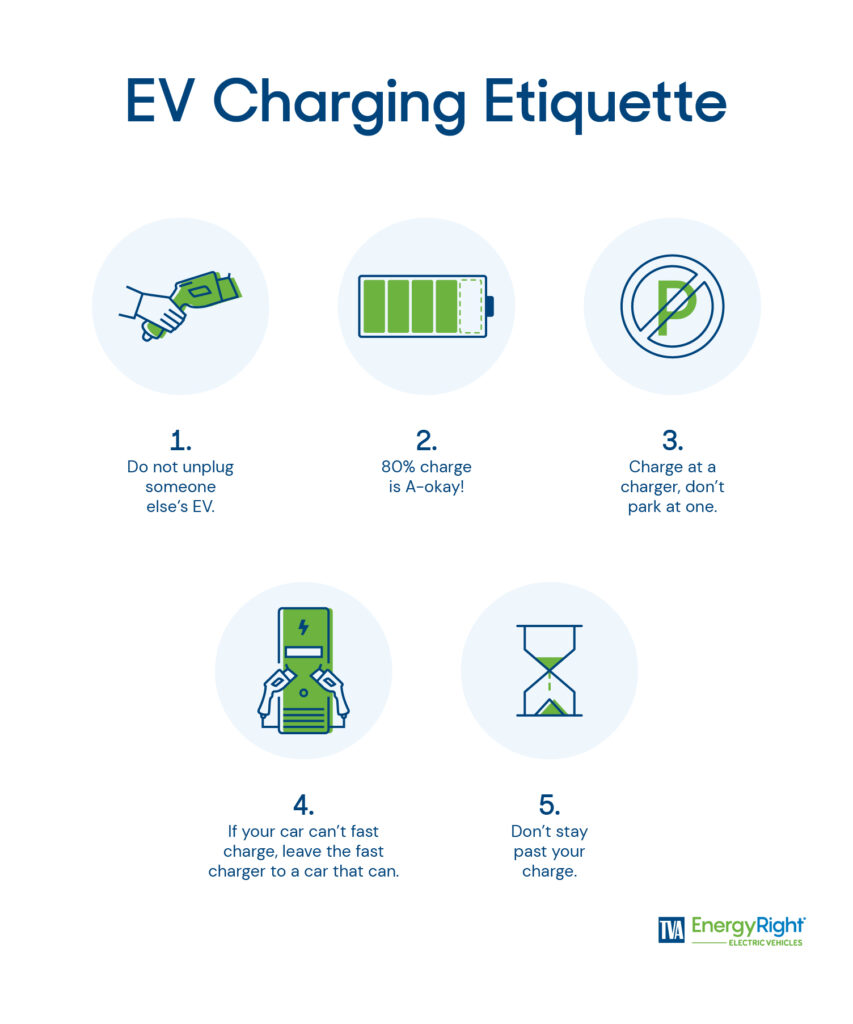
We had some fun exploring EV chargers and EV charging tips with this installment. Be sure to stay tuned: We’re already planning in-depth articles on home charging and fast charging.
In the meantime, if you’re looking for answers to general questions about electric cars or are curious about what EV owners in the region have to say, check out “Top 10 EV questions answered” and “Beginning your electric vehicle journey: EV owners share their EV tips.” For a deeper dive into EV batteries, don’t miss our Q&A about EV batteries.
We’ll help you stay on top of the latest electrifying developments. Sign up to receive news and updates from the TVA EnergyRight EV team!
This site’s content (including, without limitation, references and links to third-party information) is based on information provided at the time of publishing, and TVA makes no warranty therein.

